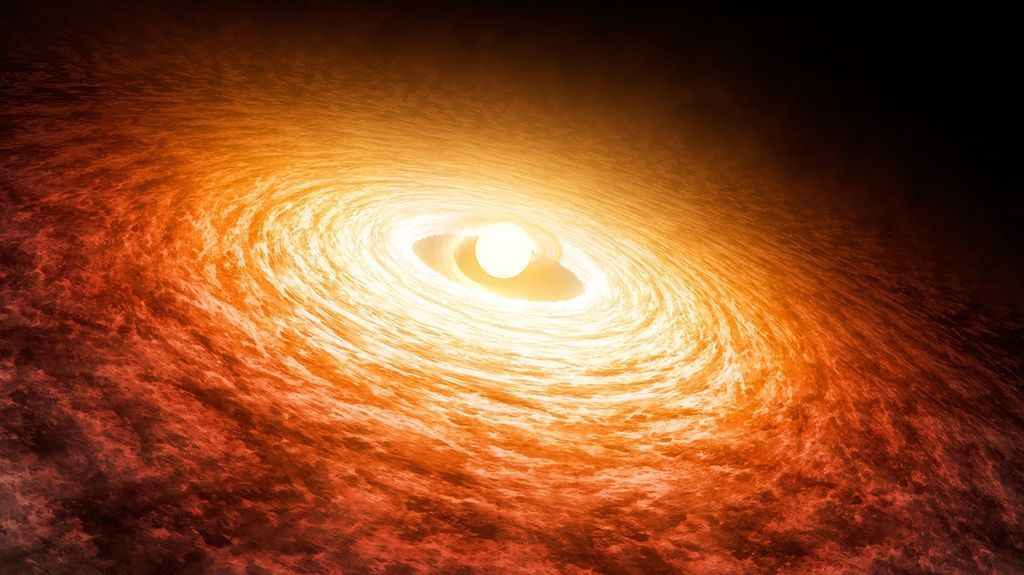A star about 1,360 light-years away from Earth, named FU Orionis, is twice as hot as astronomers previously suspected, according to recent data from the Hubble Space Telescope. In fact, scientists believe that the region where FU Orionis’s planet-forming disk touches the star’s surface glows at around 16,000 Kelvin — three times hotter than the surface of our sun.
Caltech astronomer Adolfo Carvalho and his colleagues suggest the area around the star is so surprisingly hot because a rapidly-spinning disk of material falling into the star is actually scraping against its surface, creating a shockwave that glows a hundred times brighter than the star itself. And that could create a rough environment for Earth-like planets; the star’s interaction with the disk of material around it is just too explosive for a planet like Earth — or Mars, for that matter — to form.
“You could lose, or at least completely fry, rocky planets forming close to such a star,” says Carvalho in a statement.
Related: Mysterious ‘hot Jupiter’ planets can form quickly or slowly, Gaia spacecraft reveals
A bright, but strange, young star
The bright variable star FU Orionis is one of a bizarre class of newly-formed stars. Like most young stars, it’s surrounded by a glowing disk of gas and dust, which will eventually coalesce into planets. But FU Orionis is still feeding on its disk, growing larger by consuming material that would otherwise be the building blocks of a system of planets. As the gas and dust in FU Orionis’s accretion disk spirals toward the star, it speeds up, causing the disk to glow — the hallmark of what astronomers call a “T Tauri star.”
However, FU Orionis is weird even for a T Tauri star, because its disk is unstable. That may be because there’s so much material in the disk that it becomes unbalanced; it may also be because FU Orionis is part of a binary system, influenced by the gravitational pull of a second star.
Either way, the speeding inner edge of the accretion disk sometimes scrapes against the much slower-moving surface of the star, releasing a burst of heat and light.
These outbursts, as they’re called, can last for decades; FU Orionis has been having one since 1936, when the star first flared to a hundred times its original brightness over just a few months. Typically, astronomers only see a star change so quickly when it dies in a supernova — however, unlike a supernova, FU Orionis has dimmed only slightly over the last 88 years. Astronomers then realized the bright glow they saw wasn’t starlight, but rather the glow of the disk of material swirling faster and faster around the star, pouring electrically charged gas called plasma onto the surface of the star – and outshining FU Orionis itself.
Since then, astronomers have wondered exactly what happened at the place where the inner edge of the disk scrapes against the surface of the star. They’ve built computer simulations of the physics involved, hoping to predict how the whole system works in detail. Recently, Carvalho and his colleagues peered at FU Orionis through Hubble’s ultraviolet instruments, and what they saw defied all those careful simulations.
Most models of how FU Orionis works had assumed the energy was being released by material falling onto the star. Carvalho and his colleagues, however, suggest that the best explanation is actually a shockwave from the fast-moving edge of the desk slamming into the slower-moving surface of the star and rapidly slowing down — releasing gargantuan amounts of energy in the process.
Dangerous cosmic real estate
That outburst of radiation — and the fact that the star is gobbling up the inner layers of the disk in which planets would normally be forming — could make it almost impossible for rocky Earth-like planets to form in a system like FU Orionis.
“Within a couple outbursts, any planets that are forming very close to the star can rapidly move inward and eventually merge with it,” Carvalho said. The inner part of the star system, in other words, is not a safe place for a planet to be, either because it might fall into its star or just be too radiation-scorched to be livable.
On the other hand, more distant worlds have a fighting chance: “If the planet is far out in the disk as it’s forming, outbursts from an FU Ori object should influence what kind of chemicals the planet will ultimately inherit.”
The study was published in September in The Astrophysical Journal Letters.

